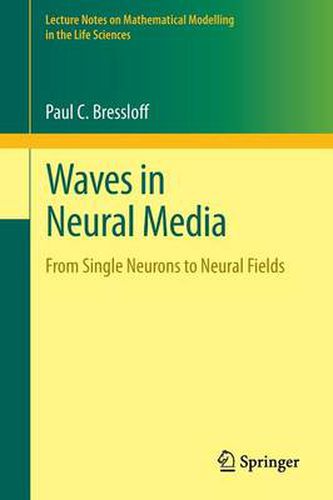Readings Newsletter
Become a Readings Member to make your shopping experience even easier.
Sign in or sign up for free!
You’re not far away from qualifying for FREE standard shipping within Australia
You’ve qualified for FREE standard shipping within Australia
The cart is loading…






This title is printed to order. This book may have been self-published. If so, we cannot guarantee the quality of the content. In the main most books will have gone through the editing process however some may not. We therefore suggest that you be aware of this before ordering this book. If in doubt check either the author or publisher’s details as we are unable to accept any returns unless they are faulty. Please contact us if you have any questions.
Waves in Neural Media: From Single Neurons to Neural Fields surveys mathematical models of traveling waves in the brain, ranging from intracellular waves in single neurons to waves of activity in large-scale brain networks. The work provides a pedagogical account of analytical methods for finding traveling wave solutions of the variety of nonlinear differential equations that arise in such models. These include regular and singular perturbation methods, weakly nonlinear analysis, Evans functions and wave stability, homogenization theory and averaging, and stochastic processes. Also covered in the text are exact methods of solution where applicable. Historically speaking, the propagation of action potentials has inspired new mathematics, particularly with regard to the PDE theory of waves in excitable media. More recently, continuum neural field models of large-scale brain networks have generated a new set of interesting mathematical questions with regard to the solution of nonlocal integro-differential equations.
Advanced graduates, postdoctoral researchers and faculty working in mathematical biology, theoretical neuroscience, or applied nonlinear dynamics will find this book to be a valuable resource. The main prerequisites are an introductory graduate course on ordinary differential equations or partial differential equations, making this an accessible and unique contribution to the field of mathematical biology.
$9.00 standard shipping within Australia
FREE standard shipping within Australia for orders over $100.00
Express & International shipping calculated at checkout
This title is printed to order. This book may have been self-published. If so, we cannot guarantee the quality of the content. In the main most books will have gone through the editing process however some may not. We therefore suggest that you be aware of this before ordering this book. If in doubt check either the author or publisher’s details as we are unable to accept any returns unless they are faulty. Please contact us if you have any questions.
Waves in Neural Media: From Single Neurons to Neural Fields surveys mathematical models of traveling waves in the brain, ranging from intracellular waves in single neurons to waves of activity in large-scale brain networks. The work provides a pedagogical account of analytical methods for finding traveling wave solutions of the variety of nonlinear differential equations that arise in such models. These include regular and singular perturbation methods, weakly nonlinear analysis, Evans functions and wave stability, homogenization theory and averaging, and stochastic processes. Also covered in the text are exact methods of solution where applicable. Historically speaking, the propagation of action potentials has inspired new mathematics, particularly with regard to the PDE theory of waves in excitable media. More recently, continuum neural field models of large-scale brain networks have generated a new set of interesting mathematical questions with regard to the solution of nonlocal integro-differential equations.
Advanced graduates, postdoctoral researchers and faculty working in mathematical biology, theoretical neuroscience, or applied nonlinear dynamics will find this book to be a valuable resource. The main prerequisites are an introductory graduate course on ordinary differential equations or partial differential equations, making this an accessible and unique contribution to the field of mathematical biology.